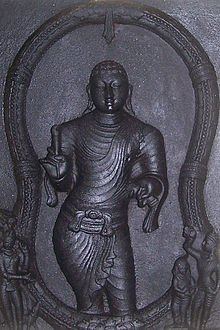

Ilango Adigal (Tamil: இளங்கோவடிகள், romanized: Iḷaṅkōvaṭikaḷ, was a monk and a poet, sometimes identified as a Chera prince.[1][2][3] He is traditionally credited as the author of Cilappatikaram, one of the Five Great Epics of Ancient Tamil literature. He is one of the greatest poets from Cheranadu (now Kerala). In a patikam (prologue) to the epic poem, he identifies himself as the brother of a famous Chera king Ceṅkuṭṭuvan (Senguttuvan). This Chera king, as stated by Elizabeth Rosen, ruled over his kingdom in late 2nd or early 3rd century CE.[4][5] However, this is doubtful because a Sangam poem in Patiṟṟuppattu – the fifth ten – provides a biography of Ceṅkuṭṭuvan, his family and rule, but never mentions that he had a brother who became an ascetic or wrote one of the most cherished epics.[6] This has led scholars to conclude that the legendary author Ilango Adikal myth was likely inserted later into the epic.[6][7] In a 1968 note, Kamil Zvelebil suggested that, "this [Adigal claim] may be a bit of poetic fantasy, practised perhaps by a later member of the Chera Dynasty [5th or 6th century[8]] recalling earlier events [2nd or 3rd century]".[4]
- ^ "Who Was Ilango Adigal? – Amar Chitra Katha". www.amarchitrakatha.com. 18 June 2020. Retrieved 13 September 2020.
- ^ Vimala, Angelina (September 2007). History And Civics 6. Pearson Education India. ISBN 978-81-317-0336-6.
- ^ Lal, Mohan (1992). Encyclopaedia of Indian Literature: Sasay to Zorgot. Sahitya Akademi. ISBN 978-81-260-1221-3.
- ^ a b Rosen, Elizabeth S. (1975). "Prince ILango Adigal, Shilappadikaram (The anklet Bracelet), translated by Alain Damelou. Review". Artibus Asiae. 37 (1/2): 148–150. doi:10.2307/3250226. JSTOR 3250226.
- ^ Adigal 1965, p. VIII.
- ^ a b Iḷaṅkōvaṭikaḷ; R Partaasarathy (2004). The Cilappatikāram: The Tale of an Anklet. Penguin Books. pp. 6–8. ISBN 978-0-14-303196-3.
- ^ Gananath Obeyesekere (1970). "Gajabahu and the Gajabahu Synchronism". The Ceylon Journal of the Humanities. 1. University of Sri Lanka: 44.
- ^ Kamil Zvelebil 1973, pp. 174–176.